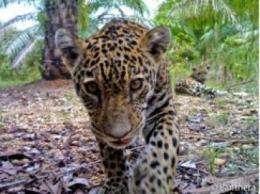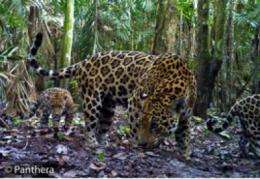First photos ever of jaguars in Colombian oil palm plantation taken with Panthera's camera traps

Panthera's camera traps recently produced the first photographic evidence of wild jaguars with cubs in an oil palm plantation in Colombia, including photos of two male jaguars and a female jaguar with cubs, and a video of a jaguar male.
Placed in the Magdalena River valley, these camera traps were set to gather new data about the impact of Colombia's ever-increasing oil palm plantations on jaguars. Panthera's scientists are working to understand the implications of these habitat changes on jaguars and their ability to travel and reproduce, as well as the impacts palm plantations have on their prey species.
In Latin America and Asia, oil palm plantations result in the clearing of expansive tracts of forest on which thousands of animal and plant species depend. Data have shown that in Indonesia, tigers avoid plantations, which serve as major barriers restricting their movement, and gene flow. In Latin America, Panthera's scientists are investigating whether oil palm plantations have similar effects on jaguars.
Rare photos of a female jaguar and her cubs taken with Panthera's camera traps confirm that, at least in some cases, jaguars are willing to move through oil palm. Importantly, the photos come from a small plantation adjacent to a protected area with some indigenous habitat present - perhaps the best case scenario for fostering jaguar use of palm oil tracts.

Panthera's Northern South America Jaguar Program Director, Dr. Esteban Payan, explained, "Typically, jaguars can move across human-dominated landscapes by travelling through riparian forests or using road underpasses, but until now, scientists had no photographic proof that jaguars entered oil palm developments in this region."
Payan added, "Given the extensive amount of jaguar habitat overtaken by oil palm plantations in Colombia, we hope that certain plantations can be part of the Jaguar Corridor, enabling jaguars to reach areas with little or no human disturbances."
Panthera's Jaguar Corridor Initiative seeks to connect and protect jaguar populations from Argentina to Mexico within human-dominated landscapes, such as oil palm plantations, to preserve the species' genetic diversity. Cupped between Panama to the north and a handful of South American countries, Colombia holds the key to the jaguar's passage from Central America to South America.
See a map of Colombia, its jaguar populations and jaguar corridors.
Panthera's Jaguar Program Executive Director, Dr. Howard Quigley, stated, "Human development in the shape of large monocultures, like oil palm plantations, are drastically changing the face of the planet, creating refugees out of wild cats by breaking up their habitats and forcing them to live within smaller, often degraded, and more isolated pockets of land. Data collected through Panthera's Jaguar Corridor Initiative are critical for oil palm growers, national policy makers and local governments in their decision making so they can account for the needs of jaguars across their range and minimize impacts on wildlife."
Panthera promotes sustainable oil palm practices, asking farmers to adhere to the Roundtable on Sustainable Palm Oil Recommendations to help curb the negative impacts of extensive agriculture development on biodiversity and enable initiatives like the Jaguar Corridor to become a reality.
Quigley added, "Our data suggest that plantations can be part of a landscape mosaic that jaguars will use. But careful planning that avoids large-scale replacement of forest with huge palm oil areas will be essential if we want to avoid the kind of isolation that tigers now suffer."
Provided by Panthera


















